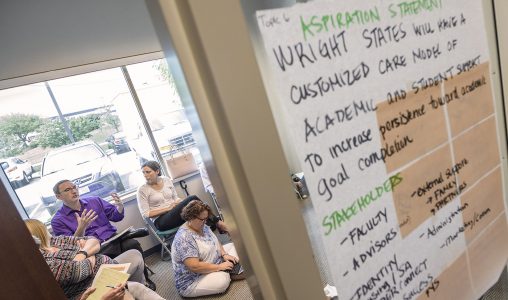
The July 13 mini-summit session will feature the “idea marketplace,” during which each of the 15 strategic initiative working groups will put on display the project ideas they have proposed for the strategic plan.
Faculty, staff, students, alumni and community partners can learn about and provide feedback on potential projects at the next strategic planning mini-summit on July 13.
The session will feature the “idea marketplace,” during which each of the 15 strategic initiative working groups will put on display the project ideas they have proposed for the strategic plan.
During the open house-style event, participants can visit each working group’s display and learn more about each project, which could have high impact on Wright State. Participants can also vote for their favorite projects.
The working groups will evaluate the feedback they receive as they consider which ideas they think should be addressed through the strategic plan.
Those who cannot attend the session can provide feedback on the proposed projects on the strategic planning website.
Remaining mini-summit schedule:
July 13: Session 4: Evaluate and Prioritize Actions
August 3: Session 5: Identify Metrics, Resources and Milestones
August 31: Session 6: Assemble the Strategic Plan
RSVP through the strategic planning website. Sessions will be held from 8:30 a.m. to noon in the first-floor gallery space at 2455 Presidential Drive.
You do not need to attend every session to participate in the process. Supervisors and managers are encouraged to provide employees with the time to attend mini-summit sessions as business conditions allow.
Participants are encouraged to wear green and gold on the dates of mini-summits to show their Wright State spirit.
Participants have formed working groups for each of the 15 strategic initiatives organized around the themes of collaborative delivery of services; research, innovation and entrepreneurship; strategic relationships and partnerships; teaching, learning and programming; and the Wright State experience.
The mini-summits provide space for the working groups to propose, evaluate and prioritize projects for the strategic plan and identify the milestones, resources and metrics to include in the strategic plan.
During the third mini-summit, on June 22, participants were challenged to think radically as they work on the strategic plan.
“If you think you’ve reached the boundary of where this university can go, then push past it,” said Doug Fecher, chair of the Wright State Board of Trustees. “We need to think about ways of serving our students that just flat out haven’t been thought of before.”
Fecher said the board is not looking for a strategic plan for today’s world of higher education, but rather one that invents a university of tomorrow because the environment of higher education has changed so markedly.
“Let’s really push the boundaries to get a plan that is different than anybody would see at another university,” he said.
Read more about the June 22 mini-summit.
Through the strategic planning process, the university is creating an ongoing dialogue that encourages continuous reflection and revision of the community’s hopes and priorities. The planning process is designed to help faculty, staff and students engage and reconnect with others across the university and with partners in the broader community in meaningful ways. Over time, this process will help the Wright State community shape both its culture and future.
The new strategic plan will guide Wright State University by creating a vision and focus that directly aligns resources with the community’s values, strengths and the strategy built around them. The planning process will put the institution in a position to thrive in higher education’s changing environment, help the university achieve financial sustainability, and foster a campus atmosphere that provides graduates with opportunities to excel in fields that define the future.

 Wright State alum Lindsay Aitchison fulfills childhood space-agency dream
Wright State alum Lindsay Aitchison fulfills childhood space-agency dream  Wright State business professor, alumnus honored by regional technology organizations
Wright State business professor, alumnus honored by regional technology organizations  Wright State University Foundation awards 11 Students First Fund projects
Wright State University Foundation awards 11 Students First Fund projects  Gov. DeWine reappoints Board Treasurer Beth Ferris and names student Ella Vaught to Wright State Board of Trustees
Gov. DeWine reappoints Board Treasurer Beth Ferris and names student Ella Vaught to Wright State Board of Trustees  Joe Gruenberg’s 40-Year support for Wright State celebrated with Honorary Alumnus Award
Joe Gruenberg’s 40-Year support for Wright State celebrated with Honorary Alumnus Award 